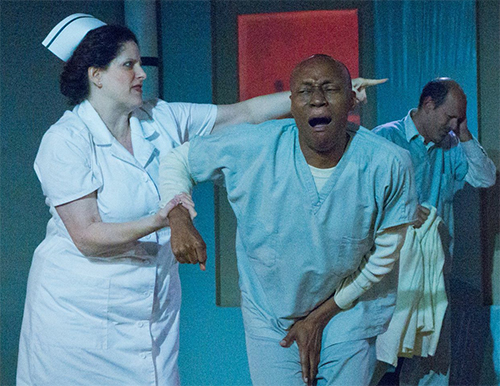Welcome to Building Character, our ongoing look at performers and how they create their roles
---
It's not every day you sit down with three Jesus Christs. Wait, what's the plural form of Jesus? Jesi? Jesuses?
"Jesees!" says Donald Warfield, one of three actors playing the son of God in
3 Christs, now at Judson Memorial Church in a production from Peculiar Works Project.
When the audience enters Judson's grand church hall, they see three men onstage, sitting with their backs to each other in a triangular formation---a trinity. In the background, above the set, stained glass windows of Peter, Paul, and John gaze upon them. It's a striking tableau about an unsettling subject.
3 Christs, adapted S.M. Dale and Barry Rowell from a real-life medical study, follows the two-year experiment of Dr. Milton Rokeach, who in 1959 brought together three schizophrenics (Leon Gabor, Joseph Cassel, and Clyde Benson). All three believed they were Jesus Christ, and Dr. Rokeach hoped that by encountering each other, they would be shaken of their delusions.
This scenario creates a fascinating acting exercise for the actors playing the Christs (as they're called by the crew). How do you make sense of insanity?
This question was posed to all three performers as they sat around a table (in triangle formation) at Judson Church, in a conversation where they played off of each other like a single holy unit.
The insanity was what initially drew Warfield, who plays Clyde, to the play. His mother worked in a psychiatric hospital, and he was intrigued by psychosis from an early age. "I've always been spooked by it," he says, "What is insanity and how does it relate to us? I think that's what's fascinating about it today. Nobody's really ever come back from extreme paranoid schizophrenia and said, 'Here, let me tell you what it's like.'"
A primary challenge is crafting performances that are comedic and tragic in equal measures. For Arthur Aulisi, who plays Joseph, the first step was believing in his character's convictions. "I started out by finding truth in all those words I had to say. Joseph truly believes that [the hospital] is an English stronghold," he says.
Joseph's facial tics and compulsive book arranging also proved helpful. "The physicality has helped me over the past week, just walking around and getting the tics going puts me in the state."
To this, Daryl Lathon, the third Christ, laughs loudly in agreement. "One of my physical cues for getting into Leon was clutching the script. It became a part of me and a part of the character. And I would be on the train running lines, and clutching the script, and I'd start to get louder. And then wait a minute, I'm turning into a crazy person on the train!"
Another challenge of playing the three Christs was their stasis; since the characters are never cured of their psychosis, they don't develop much throughout the show. But that's not the point.
"The central arc is the arc of the doctor and the nurse, and what the maniacs do is provide this sort of static background," says Warfield, "Our job is to somehow not have an arc yet keep it interesting for the audience." To that end, the Christs try to make patrons understand and feel for their characters, rather than regard them as crazy objects of curiosity. That's also why the script has Dr. Rokeach give a brief bio of each patient. For example, Leon Gabor was raised by a mother who was an abusive religious fanatic. With that piece of background information, Lathon was able to find his way into the character's tortured psyche. "We've all had people who have disappointed us in some way, form, or fashion and so you [as an actor] have to turn that up to 18 or 20," he says. "We share an emotional truth with these people even though we don't share an intellectual truth. Ultimately, that keeps us in connection with our shared humanity."
So, final question: Who is the real Jesus Christ? "I'm the real Jesus Christ," says Aulisi. Initially, one might think he's just reciting his lines, but then he takes out his wallet and flashes his driver's license. His birth date: December 25.
At that, Lathon says, "I've met his mother, the Virgin Mary, and she looks great."
---
Diep Tran is a writer and editor based in New York City
Photo by Jim R. Moore/Vaudevisuals
